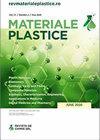负载5-氟尿嘧啶的醋酸普鲁兰纳米颗粒的制备与表征
IF 0.6
4区 材料科学
Q4 MATERIALS SCIENCE, MULTIDISCIPLINARY
引用次数: 0
摘要
本研究旨在分析负载5-氟尿嘧啶的基于醋酸普鲁兰的纳米颗粒的制备方法,以及普鲁兰作为生物聚合物基质获得用于抗癌药物(5-FU)递送的纳米颗粒的潜力。采用纳米沉淀法、改性纳米沉淀法和双乳液法制备了负载5-FU的醋酸普鲁兰基纳米颗粒。先前用乙酸酐、二甲基甲酰胺和吡啶对普鲁兰进行化学修饰,得到醋酸普鲁兰。普鲁兰是用普鲁兰小孢子菌菌株通过发酵过程制成的。采用紫外可见分光光度法和动态光散射法(DLS)对负载5-FU的醋酸普鲁兰基纳米颗粒的包封效果、粒径和多分散指数(PDI)进行了评价。根据所获得的纳米颗粒的性能,选择了最佳的制备方法。双乳法制备的负载5-FU的醋酸普鲁兰纳米颗粒包封效率最高。所有纳米颗粒的平均水动力尺寸和PDI均足够。最佳配方在酸性磷酸盐缓冲盐水(pH为5)中的5- fu释放速度比在pH为7.4的磷酸盐缓冲盐水中更快。根据这一发现,普鲁兰衍生物在生产纳米颗粒方面具有巨大的潜力,这种纳米颗粒可能被用于输送抗癌药物。本文章由计算机程序翻译,如有差异,请以英文原文为准。
Formulation and Characterisation of Pullulan Acetate Nanoparticles Loaded with 5-Fluorouracil
This study was geared to analyze the preparation methods of pullulan acetate-based nanoparticles loaded with 5-fluorouracil, as well as the potential of pullulan as a biopolymer matrix for obtaining nanoparticles applied in the delivery of anticancer drugs (5-FU). Various methods were used to produce pullulan acetate-based nanoparticles loaded with 5-FU, including nanoprecipitation, modified nanoprecipitation, and double emulsion. Pullulan was previously chemically modified with acetic anhydride, dimethylformamide and pyridine, and yielded pullulan acetate. Pullulan was made using the Aureobasidium pullulans strain through a fermentation procedure. UV-Vis Spectro-photometric and dynamic light scattering (DLS) methods were used to assess entrapment effectiveness, size, and polydispersity index (PDI) of pullulan acetate-based nanoparticles loaded with 5-FU. Based on the properties of the nanoparticles obtained, the optimum preparation method was chosen. The maximum entrapment efficiency was found in pullulan acetate nanoparticles loaded with 5-FU generated by a double emulsion method. The mean hydrodynamic size and PDI of all nanoparticles were adequate. The best formulation showed faster 5-FU release profile in acid phosphate-buffered saline (pH 5) than in phosphate-buffered saline pH 7.4. According to the findings, pullulan derivatives have a great potential for producing nanoparticles that might be used to deliver anticancer medicines.
求助全文
通过发布文献求助,成功后即可免费获取论文全文。
去求助
来源期刊

Materiale Plastice
MATERIALS SCIENCE, MULTIDISCIPLINARY-
CiteScore
1.40
自引率
25.00%
发文量
99
审稿时长
6-12 weeks
期刊介绍:
Materiale Plastice, abbreviated as Mater. Plast., publishes original scientific papers or guest reviews on topics of great interest.
The Journal does not publish memos, technical reports or non-original papers (that are a compiling of literature data) or papers that have been already published in other national or foreign Journal.
 求助内容:
求助内容: 应助结果提醒方式:
应助结果提醒方式:


